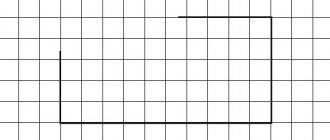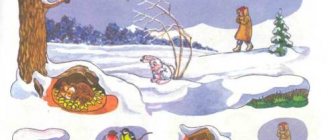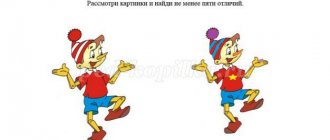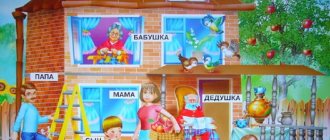As children grow up, many questions arise: “What is this?”, “What is this for?” etc. Adults should pay more attention to a child who is actively developing. In this article we will look at tips on how to easily and quickly teach kids the names of the months of the year.
Children are interested in various topics, including serious ones. When parents encounter something like this, they begin to wonder how to properly answer or explain. For example, they hear the question: “Mom (dad), what is November?” How can you explain to your child in an accessible way that there are 12 months in a year, of which 3 are winter, 3 spring, 3 summer and 3 autumn? That every month has a name, that January is a winter month, and July is a summer month? How to learn the names of all months with your child? And not just find out, but teach them to distinguish them based on specific characteristics?
Where to start learning?
It is necessary to begin the explanation with what a month is in general, how many there are in a year, and why it is customary to divide the year into seasons. Then you need to talk about the generally accepted procedure and begin training by studying the months, starting with the first - January.
Note! A quick way to remember the number of days in a month: clench your fist and look at the bones. The first is January. The month on the bone has 31 days, on the socket - 30.
Differences from other seasons
You can often hear children say that if snow has fallen, then winter has already come. But in fact, this symptom occurs both in late autumn and early spring. It is important to emphasize that snow alone does not indicate the onset of winter.
We can talk about a change of season when 5 signs coincide:
- dense, low-hanging clouds, gloomy sky;
- a blanket of snow and ice on the ground and trees;
- short daylight hours;
- hibernation of wildlife;
- appearance of “winter” birds.
Names of the months in children's pictures
All children love games. It will be more interesting and easier for your child to learn the names of the months if he is shown story-based illustrations or presentations. If parents independently make a presentation about the seasons for their child, it will be even better. An excellent option is to create it together with your child. This way he will remember the names faster.
By finding illustrations about each month and showing them to the child, the parent will be able to fix their names in his memory. To do this, you need to select pictures that demonstrate the life of animals in each season, the type of clothing for each season, etc.
To interest your son (daughter), the presentation must be colorful. You can also display the features of each month. For example, September - leaves fall, the school year begins, and children go to school. In presentations, you can focus on holidays. For example, December - New Year, decorating the Christmas tree and home. Be sure to include the child’s birthday in them - he will definitely know and remember this day.
Winter months
The child needs to be explained that there are 3 winter months - December (ends the year and begins winter), January (begins the year) and February (the harshest month, with blizzards and snowfalls). It is important to choose thematic pictures for the story.
Spring months
The first month of spring is March. This is the period when primroses - snowdrops - appear. The second month is called April. This is a period of changeable weather: sometimes the sun shines, sometimes it rains. The third month – May – is the time when nature begins to clothe the forest. Plot illustrations are also appropriate for the explanation.
Summer months
June is the first month of summer. In ancient times it was called “worm”. This month has the longest day and shortest night of the year - June 22. June is followed by July, the month when linden blossoms intensively. Summer ends - August - time for harvest. In addition to pictures, you can choose riddles that describe each month.
Autumn months
There are also 3 autumn months: September (early autumn), October (golden autumn) and November (late autumn). To describe the season, you can select signs for each month.
Visual game: seasons
Take four sheets of paper, preferably in different colors: white for winter, blue for spring, green for summer and yellow for autumn. An adult draws a tree with branches on each sheet. And then you need to transform each tree together with your baby, according to the seasons.
The winter one will be covered with a layer of white cotton wool or semolina like snow. In the spring, small green dotted leaves will appear, drawn with a cotton swab. The summer one will have large green leaves and flowers, which can be made from pre-dyed pasta or cut out from construction paper. Fall can be decorated with bright buttons or bright red and orange brush blots.
Advice:
First of all, you need to draw the child’s attention to how this or that season differs from another.
Winter.
It's cold, it's snowing. You can sled, ski and skate, and also make snowmen and play snowballs. We dress in warm clothes, wear mittens and hats with scarves. And in winter the New Year comes, and Grandfather Frost gives us gifts.
Spring.
Snow is melting. It is getting warmer. You can put your fur coat and mittens in the closet and put on a light jacket. The birds are returning. The first leaves and grass appear.
Summer.
It is hot outside. Everything is green, lots of flowers. We eat fruits and berries, swim and sunbathe. Everyone rides scooters and bicycles.
Autumn.
The leaves are turning yellow. The birds are flying away. It's getting cold and it's starting to rain. You need umbrellas, raincoats, rubber boots.
It is very convenient to teach the seasons, “starting” from the baby’s wardrobe. Together, put together a set of clothes to go outside in winter or summer. You can use dress-up games: paper dolls that change clothes (they can be magnetic or with Velcro).
When the first stage is mastered, it will be possible to tell in detail what is happening to nature, to water, what animals are doing. Get ready to answer a hundred thousand questions. A colorful children's encyclopedia will help you.
After you have talked about everything, it’s time to consolidate the material, and here you can’t do without games. For example, you can sort cards with pictures by season, or name what people do in the fall and what in the spring.
You can prepare 4 small boxes, decorate them beautifully and, together with your baby, fill the boxes with “memories” of summer, autumn, winter and spring. Sort out your family photo archive and make a “calendar” of photos. The baby will see how he himself looked in the fall and spring, what he was wearing and what he did outside in winter and summer.
Draw your child’s attention to changes outside the window more often. Explain that it can rain in summer, and that the sun shines in winter, but it does not warm. Tell your child as much as possible about the world around him and answer all his questions, and then soon he will not confuse winter with spring, and summer with autumn. And after a little more time he will be able to list all the months of the year, and in the correct order!
Advice:
It makes sense to teach your child the months of the year no earlier than 4-4.5 years. Of course, it’s difficult for kids to understand a month as a period of time, so at first it will just be encyclopedic knowledge.
One of the most effective ways to learn about the seasons is to associate each of them with a holiday. So, winter is New Year, spring is March 8, summer is vacation, autumn is Knowledge Day. And it will be easy for the child to remember the season and month when his birthday is celebrated.
How to learn the names of the months from books
Experts recommend buying children's educational and developmental books about the seasons and months. Such manuals explain to children the features of nature and the signs of the months in an accessible way. Some editions of such books contain tasks for consolidating material that will strengthen the memory of the topic studied.
Poems can help you learn the names of the months. After studying them, your memory will improve. You need to buy special literature with poems, fairy tales and stories about the 12 months. The book “365 Bedtime Stories” has proven itself to be excellent. The pictures in it are sorted by season, and each page corresponds to one calendar day. The book contains poems and stories that fully explore the theme of the 12 months. It's great for teaching with kids. No less useful is the encyclopedia “Seasons” with answers to many questions.
Books about the seasons
- Series “Town” by Susanne Rotraut Berner. Spring, Winter, Summer, Autumn. These are books without words. You look at them and come up with stories yourself. There are a lot of characters in the pictures, which are very interesting to look for and not always easy to find.
- “Titmouse Calendar” by Bianchi.
- Vladimir Svechnikov “Seasons. Illustrated Encyclopedia".
- Elena Ulyeva “Creative tasks. Seasons".
- Tatyana Romanova “We play in the seasons. 40 savvy ideas for kids."
- S. Marshak “All year round.”
- Alexander Golubev “Summer Adventures of Klevik” (there is a book about winter, spring and autumn).
Learn the names of the months by playing
Theatrical scenes will help your child remember the names of the months and seasons. The child can be both a participant and a spectator. You can also pick up riddles or come up with them yourself. For example, draw people wearing clothes according to the seasons and ask the child to name what time of year they wear such clothes. Drawing pictures with your child that correspond to each season will also be useful.
A great way to learn and remember the months is a didactic game. They are developed specifically for preschool children. They also demonstrate relationships with the environment, develop memory and logic.
Information that is interesting to children is remembered quickly. They always want to learn a lot of new things, so they ask adults questions and explore the world. Children are good communicators who know how to listen. Studying the months is a fun topic for a child. He will be happy to study it with mom or dad.
What are the 15 signs to recognize winter?
Changes in nature in winter are the most profound and significant. All living things fall asleep, and non-living things freeze, becoming cold and hard.
15 signs that characterize the season:
- cold weather;
- trees without leaves, sometimes with a snow cap on the branches;
- short days and long nights;
- ice crust on puddles, sleet;
- snowdrifts and snow;
- low, gray, heavy clouds;
- bitter frosts;
- blizzard;
- winter fun - ice skating, sledding, snowball fights;
- smoke pours out of the chimneys of houses (in the modern world without stove heating - steam);
- traces of animals and birds in the snow are clearly visible;
- frosty air and steam from the mouth;
- winter holidays - New Year, Christmas, Epiphany;
- an abundance of tits, rooks, crows, the appearance of bullfinches, crossbills and other migratory birds;
- hibernation in insects, fish and some animals (bears, hedgehogs, marmots).
People have long considered frosts to be the first sign of winter, and its end was heralded by the melting of snow. When sub-zero temperatures are established, wildlife falls into suspended animation - trees and shrubs shed their remaining foliage, and fish, insects and individual animals hibernate. Other animals grow a warm undercoat, and the gray hare turns white to blend in with the snow and thus camouflage itself from predators.
Once upon a time, our ancestors gave names to the winter months based on their characteristic features. December used to be called “breasts” - from the word “breasts” or frozen clods of dirt. At the beginning of winter there is still little snow, but the ground has already begun to freeze. Its second name is jelly, from the word icy, cold. January was called the section. It was time to cut down trees. February is characterized by severe frosts, which is why it was called severe.





